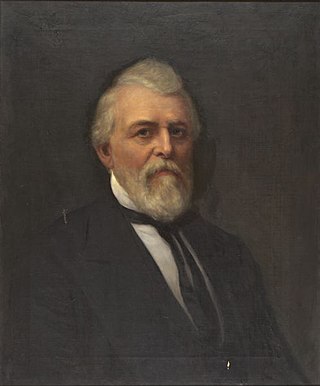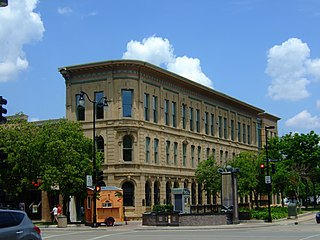Related Research Articles

Des Moines County is located in the U.S. state of Iowa. As of the 2020 census, the population was 38,910. The county seat and largest city is Burlington. It is one of Iowa's two original counties along with Dubuque County; both were organized by the Michigan Territorial legislature in 1834.

Burlington is a city in, and the county seat of, Des Moines County, Iowa, United States. The population was 23,982 in the 2020 census, a decline from the 26,839 population in 2000. Burlington is the center of a micropolitan area, which includes West Burlington and Middletown, Iowa, and Gulfport, Illinois. Burlington is the home of Snake Alley, the crookedest street in the world.

The Territory of Iowa was an organized incorporated territory of the United States that existed from July 4, 1838, until December 28, 1846, when the southeastern portion of the territory was admitted to the Union as the state of Iowa. The remainder of the territory would have no organized territorial government until the Minnesota Territory was organized on March 3, 1849.

The Territory of Wisconsin was an organized and incorporated territory of the United States that existed from July 3, 1836, until May 29, 1848, when an eastern portion of the territory was admitted to the Union as the State of Wisconsin. Belmont was initially chosen as the capital of the territory. In 1837, the territorial legislature met in Burlington, just north of the Skunk River on the Mississippi, which became part of the Iowa Territory in 1838. In that year, 1838, the territorial capital of Wisconsin was moved to Madison.

Moses Henry Dodge was an American politician and military officer who was Democratic member to the U.S. House of Representatives and U.S. Senate, Territorial Governor of Wisconsin and a veteran of the Black Hawk War. His son, Augustus C. Dodge, served as a U.S. Senator from Iowa; the two were the first and so far the only father-son pair to serve concurrently in the Senate, which they did from 1848 to 1855.

Lucius Lyon was a U.S. statesman from the state of Michigan. Along with Louis Campau, Lucius Lyon is remembered as one of the founding fathers of Grand Rapids, Michigan, the state's second-largest city. A Democrat, he served as a Delegate to the U.S. House from Michigan Territory (1833–1835), a U.S. Senator from Michigan (1837–1839), and a member of the U.S. House of Representatives from Michigan's second congressional district (1843–1845).

The Illinois State Capitol, located in Springfield, Illinois, houses the legislative and executive branches of the government of the U.S. state of Illinois. The current building is the sixth to serve as the capitol building since Illinois was admitted to the United States in 1818. Built in the architectural styles of the French Renaissance and Italianate, it was designed by Cochrane and Garnsey, an architecture and design firm based in Chicago. Ground was broken for the new capitol on March 11, 1868, and the building was completed twenty years later for a total cost of $4.5 million.

First Capitol Historic Site is a free-admission historic museum located outside Belmont, Wisconsin, United States. The museum includes two of the buildings first used by legislators to meet in Wisconsin Territory. Currently owned and operated by the Wisconsin Historical Society, the site is listed on the National Register of Historic Places.
Isaac Leffler, sometimes spelled Lefler or Loeffler, was an American lawyer and Iowa pioneer who represented Virginia's 18th congressional district in the United States House of Representatives for one term in the 1820s. He also served in the legislatures of the Commonwealth of Virginia, as well as the Wisconsin and Iowa Territories. His younger brother, Shepherd Leffler, became one of Iowa's first congressmen after achieving statehood.

William Williams Chapman was an American politician and lawyer in Oregon and Iowa. He was born and raised in Virginia. He served as a United States Attorney in Iowa when it was part of the Michigan and Wisconsin territories, and then represented the Iowa Territory in the United States House of Representatives. He later immigrated to the Oregon Country, where he served in the Oregon Territorial Legislature.
The Hawk Eye is a general-circulation newspaper based in Burlington, Iowa, United States, and bills itself as "Iowa's Oldest Newspaper."

Moses McCure Strong was an American lawyer, politician, businessman, and Wisconsin pioneer. He was one of the framers of the Constitution of Wisconsin, a member of the territorial legislature, and United States Attorney for the Wisconsin Territory under President Martin Van Buren. After Wisconsin achieved statehood, he was Speaker of the Wisconsin State Assembly during the 3rd Wisconsin Legislature.

The American Exchange Bank is an Italian Renaissance Revival-style business block built in 1871 in Madison, Wisconsin, and is one of the last such structures left on the Capitol Square. It was added to the National Register of Historic Places in 1980. The bank was also designated a landmark by the Madison Landmarks Commission in 1975.
Peter Hill Engle was an American lawyer, judge, and Iowa pioneer. He served as the first Speaker of the Legislative Assembly of the Wisconsin Territory after it was established, when it still contained the territory of the future states of Iowa and Minnesota. He later served as a judge of the St. Louis County, Missouri, Court of Common Pleas from 1841 until his death.
The First Legislative Assembly of the Wisconsin Territory convened from October 25, 1836, to December 9, 1836, and from November 6, 1837, to January 20, 1838, in regular session. The Assembly also convened in special session from June 11, 1838, to June 25, 1838.
Joseph Bartlett Teas was an American lawyer and minister from Mt. Pleasant, Iowa. He served in the legislatures of three Territories of the United States without ever moving.
The Territory of Iowa Legislative Assembly or Legislative Assembly of Iowa Territory was the legislature of Iowa Territory, which operated between the creation of the territory in 1838 and statehood in 1846.
John Parker was a local American politician in Dubuque County in the Iowa District of what was first the Michigan Territory, then the Wisconsin Territory, and eventually the Iowa Territory. He was elected to the last legislature of the old Michigan Territory to represent his district; but did not attend.
Allen Hill was an American physician from Dubuque County in the Iowa District of what was first the Michigan Territory, then the Wisconsin Territory, and eventually the Iowa Territory. He was elected to the last legislature of the old Michigan Territory to represent his district; but did not attend.
References
- ↑ Turner, A. J., ed. The legislative manual of the state of Wisconsin: comprising the constitution of the United States and of the state of Wisconsin, Jefferson's manual, forms and laws for the regulation of business; also, lists and tables for reference, etc. Twelfth Annual Edition. Madison: Atwood and Culver, Printers and Stereotypers, 1873; pp. 137-139
- ↑ Antrobus, Augustine M. History of Des Moines County Iowa and Its People Volume 1. Chicago: The S. J. Clarke Publishing Company, 1915; pp. 50-51, 95-97, 105-106; 382; 504
- ↑ Salter, William. Iowa, the First Free State in the Louisiana Purchase: From Its Discovery to the Admission of the State Into the Union, 1673-1846 Chicago: A.C. McClurg, 1905; pp. 191-94
- ↑ Antrobus, Augustine M. History of Des Moines County Iowa and Its People Volume 1. Chicago: The S. J. Clarke Publishing Company, 1915; pp. 110-111
- ↑ "Democratic Party Meeting", Iowa State Gazette May 25, 1844; p. 3, col. 1 via Newspapers.com
- ↑ "Jeremiah Smith Built Iowa’s First Capitol" Pieces of Iowa’s Past Des Moines: Iowa State Capitol Tour Guides, April 3, 2012; pp. 1-4